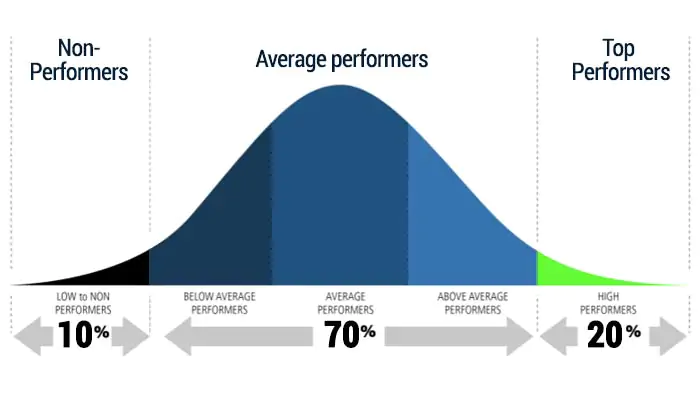Performance Appraisal is a periodic review of an employee’s job performance. It involves evaluating their achievements and shortcomings and providing feedback. Employees get promotions, bonuses, pay hikes or even terminations based on this exercise. The Human Resource department plays a significant role in designing the performance appraisal module. There are several employee performance assessment examples that companies follow, including:
- 360-degree feedback Appraisal System
- Behaviourally Anchored Rating Scale (BARS)
- Critical Incident Method
- Human Resource (Cost) Accounting Method
- Assessment Centre Method
- Bell Curve Method


Understanding the Bell Curve: How Does it Work
The Bell Curve is a graph shaped like a bell, and it depicts a normal distribution. It is a sample of many variables, with most of them concentrated around the middle of this curve. Only a small number of people are the outliers who lie on the extremities of this curve. The performance of a large group of employees gets evaluated using this method. But with the constantly evolving nature of this corporate world, the Bell Curve method is becoming redundant.
Limitations of the Bell Curve
The Bell Curve has become redundant as an appraisal mechanism in recent times. Its limited scope in assessing individual employee performances affects the business operations adversely.
No Appreciation for Teamwork
The Bell Curve formula does not work for organizational functions that depend more on teamwork. Individual appraisals are more effective in collaborative teams. Bell Curve method has become increasingly irrelevant of evaluating employees. The Human Resources team should look at other employee performance assessment examples to replace the Bell Curve.
Outdated and Rigid
Bell curve in HR and other departments has become outmoded in today’s corporate world. A company’s management can only put a limited number of people in the top performers’ category. Managers tend to put employees in specific gradients within the Bell Curve formula. This can dampen employees’ morale who performed very well but got categorized as average or below-average performers. The bell curve method can also lead to employees leaving the company to seek better recognition elsewhere.
Fears, Careers, Robot Peers: PyjamaHR Support Pros Talk AI
Join us for an authentic conversation with members of Help Scout’s own customer service team as they discuss the ways AI is changing their jobs, how they really feel about it, and how they’re taking charge of their own career direction.
Not Suitable for Small Companies
The Bell Curve formula does not work for companies with less than 150 employees. Putting employees into the top, average or low performer categories makes the appraisal unfair for many of them. Employee ratings using the bell curve in HR or other departments with a smaller workforce is an erroneous measure.
Inaccurate
Inaccurate rating is a huge problem with using the bell-shaped curve. Under the bell curve appraisal, only a fixed number/percentage of employees within a group can get the top performer ratings. This system is unfair for those who did equally well but didn’t get the recognition they deserved.
Restricted Rankings
The Bell Curve appraisals lead to distorted ratings. Many deserving candidates don’t get a place in the top bracket under the bell-shaped curve. But some below-par performers stay in the mid-range bracket. Almost 80% of any team getting a bell curve appraisal fall in the average performer category. It forces management to allocate considerable budgets for that group.
Conclusion
Companies are shifting away from the bell curve because of the above-mentioned issues. Some of the employee performance assessment examples that firms use are as follows:
- Management by Objectives (MBO) – Managers and employees set goals for an appraisal period and evaluate the progress in achieving those objectives at the end of the cycle.
- 360-degree feedback – It measures employee performance by collecting feedback from managers, customers, peers and subordinates.
- Human Resource (Cost) Accounting Methods – This method measures an employee’s performance by the monetary benefits they yield to a company.

